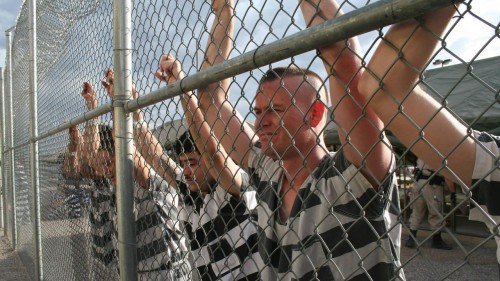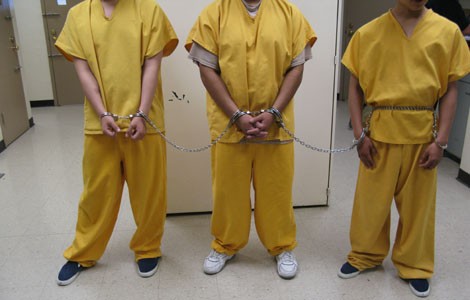TomDispatch.com & http://www.lewrockwell.com
If all you’ve got is a hammer, then everything starts to look like a nail. And if police and prosecutors are your only tool, sooner or later everything and everyone will be treated as criminal. This is increasingly the American way of life, a path that involves “solving” social problems (and even some non-problems) by throwing cops at them, with generally disastrous results. Wall-to-wall criminal law encroaches ever more on everyday life as police power is applied in ways that would have been unthinkable just a generation ago.
By now, the militarization of the police has advanced to the point where “the War on Crime” and “the War on Drugs” are no longer metaphors but bland understatements. There is the proliferation of heavily armed SWAT teams, even in small towns; the use of shock-and-awe tactics to bust small-time bookies; the no-knock raids to recover trace amounts of drugs that often result in the killing of family dogs, if not family members; and in communities where drug treatment programs once were key, the waging of a drug version of counterinsurgency war. (All of this is ably reported on journalist Radley Balko’s blog and in his book, The Rise of the Warrior Cop.) But American over-policing involves far more than the widely reported up-armoring of your local precinct. It’s also the way police power has entered the DNA of social policy, turning just about every sphere of American life into a police matter.
The School-to-Prison Pipeline
It starts in our schools, where discipline is increasingly outsourced to police personnel. What not long ago would have been seen as normal childhood misbehavior – doodling on a desk, farting in class, a kindergartener’s tantrum – can leave a kid in handcuffs, removed from school, or even booked at the local precinct. Such “criminals” can be as young as seven-year-old Wilson Reyes, a New Yorker who was handcuffed and interrogated under suspicion of stealing five dollars from a classmate. (Turned out he didn’t do it.)
Though it’s a national phenomenon, Mississippi currently leads the way in turning school behavior into a police issue. The Hospitality State has imposed felony charges on schoolchildren for “crimes” like throwing peanuts on a bus. Wearing the wrong color belt to school got one child handcuffed to a railing for several hours. All of this goes under the rubric of “zero-tolerance” discipline, which turns out to be just another form of violence legally imported into schools.
Despite a long-term drop in youth crime, the carceral style of education remains in style. Metal detectors — a horrible way for any child to start the day — are installed in ever more schools, even those with sterling disciplinary records, despite the demonstrable fact that such scanners provide no guarantee against shootings and stabbings.
Every school shooting, whether in Sandy Hook, Connecticut, or Littleton, Colorado, only leads to more police in schools and more arms as well. It’s the one thing the National Rifle Association and Democratic senators can agree on. There are plenty of successful ways to run an orderly school without criminalizing the classroom, but politicians and much of the media don’t seem to want to know about them. The “school-to-prison pipeline,” a jargon term coined by activists, isentering the vernacular.
Go to Jail, Do Not Pass Go
Even as simple a matter as getting yourself from point A to point B can quickly become a law enforcement matter as travel and public space are ever more aggressively policed. Waiting for a bus? Such loitering just got three Rochester youths arrested. Driving without a seat belt can easily escalate into an arrest, even if the driver is a state judge. (Notably, all four of these men were black.) If the police think you might be carrying drugs, warrantless body cavity searches at the nearest hospital may be in the offing — you will be sent the bill later.
Air travel entails increasingly intimate pat-downs and arbitrary rules that many experts see as nothing more than “security theater.” As for staying at home, it carries its own risks as Harvard professor Henry Louis Gates found out when a Cambridge police officer mistook him for a burglar and hauled him away — a case that is hardly unique.

Overcriminalization at Work
Office and retail work might seem like an unpromising growth area for police and prosecutors, but criminal law has found its way into the white-collar workplace, too. Just ask Georgia Thompson, a Wisconsin state employee targetedby a federal prosecutor for the “crime” of incorrectly processing a travel agency’s bid for state business. She spent four months in a federal prison before being sprung by a federal court. Or Judy Wilkinson, hauled away in handcuffs by an undercover cop for serving mimosas without a license to the customers in her bridal shop. Or George Norris, sentenced to 17 months in prison for selling orchids without the proper paperwork to an undercover federal agent.
Increasingly, basic economic transactions are being policed under the purview of criminal law. In Arkansas, for instance, Human Rights Watch reports that a new law funnels delinquent (or allegedly delinquent) rental tenants directly to the criminal courts, where failure to pay up can result in quick arrest and incarceration, even though debtor’s prison as an institution was supposed to have ended in the nineteenth century.
And the mood is spreading. Take the asset bubble collapse of 2008 and the rising cries of progressives for the criminal prosecution of Wall Street perpetrators, as if a fundamentally sound financial system had been abused by a small number of criminals who were running free after the debacle. Instead of pushing a debate about how to restructure our predatory financial system, liberals in their focus on individual prosecution are aping the punitive zeal of the authoritarians. A few high-profile prosecutions for insider trading (which had nothing to do with the last crash) have, of course, not changed Wall Street one bit.
Criminalizing Immigration
The past decade has also seen immigration policy ingested by criminal law. According to another Human Rights Watch report — their U.S. division is increasingly busy — federal criminal prosecutions of immigrants for illegal entry have surged from 3,000 in 2002 to 48,000 last year. This novel application of police and prosecutors has broken up families and fueled the expansion of for-profit detention centers, even as it has failed to show any stronger deterrent effect on immigration than the civil law system that preceded it. Thanks to Arizona’s SB 1070 bill, police in that state are now licensed to stop and check the papers of anyone suspected of being undocumented — that is, who looks Latino.
Meanwhile, significant parts of the US-Mexico border are now militarized (as increasingly is the Canadian border), including what seem to resemble free-fire zones. And if anyone were to leave bottled water for migrants illegally crossing the desert and in danger of death from dehydration, that good Samaritan should expect to face criminal charges, too. Intensified policing with aggressive targets for arrests and deportations are guaranteed to be a part of any future bipartisan deal on immigration reform.
Digital Over-Policing
As for the Internet, for a time it was terra nova and so relatively free of a steroidal law enforcement presence. Not anymore. The late Aaron Swartz, a young Internet genius and activist affiliated with Harvard University, was caught downloading masses of scholarly articles (all publicly subsidized) from an open network on the MIT campus. Swartz was federally prosecuted under the capacious Computer Fraud and Abuse Act for violating a “terms and services agreement” — a transgression that anyone who has ever disabled a cookie on his or her laptop has also, technically, committed. Swartz committed suicide earlier this year while facing a possible 50-year sentence and up to a million dollars in fines.
Since the summer, thanks to whistleblowing contractor Edward Snowden, we have learned a great deal about the way the NSA stops and frisks our (and apparently everyone else’s) digital communications, both email and telephonic. The security benefits of such indiscriminate policing are far from clear, despite the government’s emphatic but inconsistent assurances otherwise. What comes into sharper focus with every volley of new revelations is the emerging digital infrastructure of what can only be called a police state.
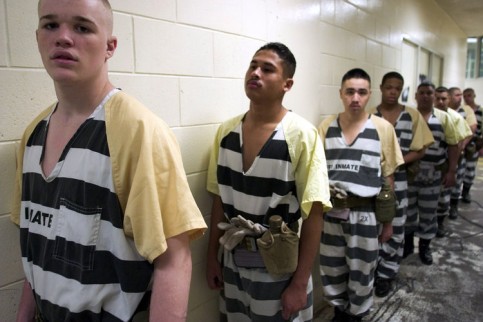
Sex Police
Sex is another zone of police overkill in our post-Puritan land. Getting put on a sex offender registry is alarmingly easy — as has been done to children as young as 11 for “playing doctor” with a relative, again according to Human Rights Watch. But getting taken off the registry later is extraordinarily difficult. Across the nation, sex offender registries have expanded massively, especially in California, where one in every 380 adults is now a registered sex offender, creating a new pariah class with severe obstacles to employment, housing, or any kind of community life. The proper penalty for, say, an 18-year-old who has sex with a 14-year-old can be debated, but should that 18-year-old’s life really be ruined forever?
Equality Before the Cops?
It will surprise no one that Americans are not all treated equally by the police. Law enforcement picks on kids more than adults, the queer more than straight, Muslims more than Methodists – Muslims a lot more than Methodists — antiwar activists more than the apolitical. Above all, our punitive state targets the poor more than the wealthy and Blacks and Latinos more than white people.
A case in point: after the 1999 massacre at Columbine High School, a police presence, including surveillance cameras and metal detectors, was ratcheted up at schools around the country, particularly in urban areas with largely working-class black and Latino student bodies. It was all to “protect” the kids, of course. At Columbine itself, however, no metal detector was installed and no heavy police presence intruded. The reason was simple. At that school in the Colorado suburb of Littleton, the mostly well-heeled white families did not want their kids treated like potential felons, and they had the status and political power to get their way. But communities without such clout are less able to push back against the encroachments of police power.
Even Our Prisons Are Over-Policed
The over-criminalization of American life empties out into our vast, overcrowded prison system, which is itself over-policed. The ultimate form of punitive control (and torture) is long-term solitary confinement, in which 80,000 to 100,000 prisoners are encased at any given moment. Is this really necessary? Solitary is no longer reserved for the worst or the worst or most dangerous prisoners but can be inflicted on ones who wear Rastafari dreadlocks, have a copy of Sun Tzu’s Art of War in their cell, or are in any way suspected, no matter how tenuous the grounds, of gang affiliations.
Not every developed nation does things this way. Some 30 years ago, Great Britain shifted from isolating prisoners to, whenever possible, giving them greater responsibility and autonomy — with less violent results. But don’t even bring the subject up here. It will fall on deaf ears.
Extreme policing is exacerbated by extreme sentencing. For instance, more than 3,000 Americans have been sentenced to life terms without chance of parole for nonviolent offenses. These are mostly but not exclusively drug offenses, including life for a pound of cocaine that a boyfriend stashed in the attic; selling LSD at a Grateful Dead concert; and shoplifting three belts from a department store.
Our incarceration rate is the highest in the world, triple that of the now-defunct East Germany. The incarceration rate for African American men is about five times higher than that of the Soviet Union at the peak of the gulag.
The Destruction of Families
Prison may seem the logical finale for this litany of over-criminalization, but the story doesn’t actually end with those inmates. As prisons warehouse ever more Americans, often hundreds of miles from their local communities, family bonds weaken and disintegrate. In addition, once a parent goes into the criminal justice system, his or her family tends to end up on the radar screens of state agencies. “Being under surveillance by law enforcement makes a family much more vulnerable to Child Protective Services,” says Professor Dorothy Roberts of the University of Pennsylvania Law school. An incarcerated parent, especially an incarcerated mother, means a much stronger likelihood that children will be sent into foster care, where, according to one recent study, they will be twice as likely as war veterans to suffer from PTSD.
In New York State, the Administration for Child Services and the juvenile justice system recently merged, effectively putting thousands of children in a heavily policed, penalty-based environment until they age out. “Being in foster care makes you much more vulnerable to being picked up by the juvenile justice system,” says Roberts. “If you’re in a group home and you get in a fight, that could easily become a police matter.” In every respect, the creeping over-criminalization of everyday life exerts a corrosive effect on American families.
Do We Live in a Police State?
The term “police state” was once brushed off by mainstream intellectuals as the hyperbole of paranoids. Not so much anymore. Even in the tweediest precincts of the legal system, the over-criminalization of American life is remarked upon with greater frequency and intensity. “You’re probably a (federal) criminal” is the accusatory title of a widely read essay co-authored by Judge Alex Kozinski of the 9th Circuit of the U.S. Court of Appeals. A Republican appointee, Kozinski surveys the morass of criminal laws that make virtually every American an easy target for law enforcement. Veteran defense lawyer Harvey Silverglate has written an entire book about how an average American professional could easily commit three felonies in a single day without knowing it.
The daily overkill of police power in the U.S. goes a long way toward explaining why more Americans aren’t outraged by the “excesses” of the war on terror, which, as one law professor has argued, are just our everyday domestic penal habits exported to more exotic venues. It is no less true that the growth of domestic police power is, in this positive feedback loop, the partial result of our distant foreign wars seeping back into the homeland (the “imperial boomerang” that Hannah Arendt warned against).
Many who have long railed against our country’s everyday police overkill have reacted to the revelations of NSA surveillance with detectable exasperation: of course we are over-policed! Some have even responded with peevish resentment: Why so much sympathy for this Snowden kid when the daily grind of our justice system destroys so many lives without comment or scandal? After all, in New York, the police department’s “stop and frisk” tactic, which targets African American and Latino working-class youth for routinized street searches, was until recently uncontroversial among the political and opinion-making class. If “the gloves came off” after September 11, 2001, many Americans were surprised to learn they had ever been on to begin with.
A hammer is necessary to any toolkit. But you don’t use a hammer to turn a screw, chop a tomato, or brush your teeth. And yet the hammer remains our instrument of choice, both in the conduct of our foreign policy and in our domestic order. The result is not peace, justice, or prosperity but rather a state that harasses and imprisons its own people while shouting ever less intelligibly about freedom.
Reprinted with permission from TomDispatch.com.



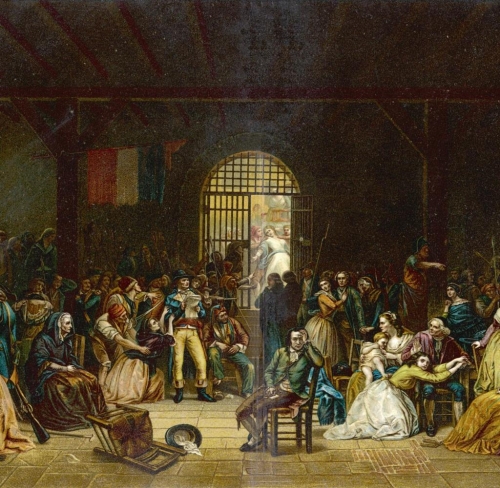
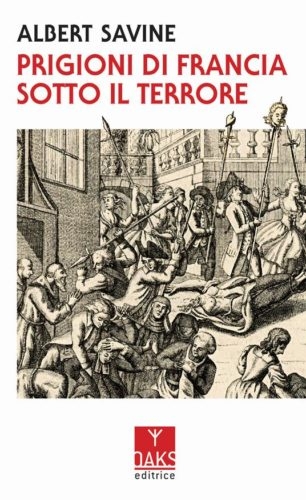 Beaucoup a été écrit et dit sur la Révolution française. C'est un événement paradigmatique de l'histoire, un moment culminant de l'avènement du monde moderne. Maintenant sur les étagères des éditions OAKS, nous trouvons un volume qui permet au lecteur d'avoir un aperçu complet de ce tournant décisif. Nous nous référons au livre d'Albert Savine, Prisons de France sous la Terreur, présenté par Giovanni Damiano (sur commande :
Beaucoup a été écrit et dit sur la Révolution française. C'est un événement paradigmatique de l'histoire, un moment culminant de l'avènement du monde moderne. Maintenant sur les étagères des éditions OAKS, nous trouvons un volume qui permet au lecteur d'avoir un aperçu complet de ce tournant décisif. Nous nous référons au livre d'Albert Savine, Prisons de France sous la Terreur, présenté par Giovanni Damiano (sur commande : 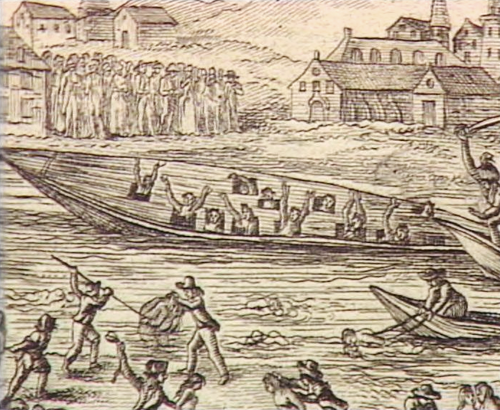

 del.icio.us
del.icio.us
 Digg
Digg